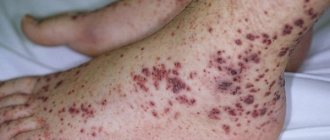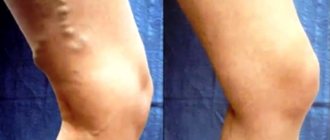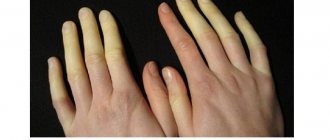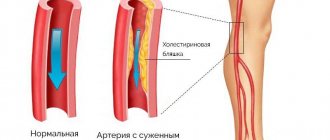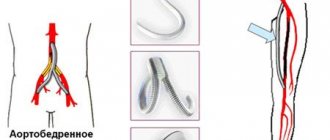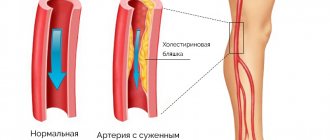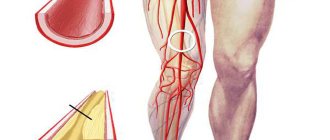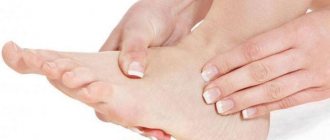Obliterating endarteritis (OE) is a chronic disease characterized by dystrophic damage to the vascular wall with subsequent scarring. Pathology leads to gradual obliteration of the arteries - narrowing of their lumen. Its complete closure leads to ischemia and necrosis of tissues deprived of blood supply. A frequent complication of the pathology is spontaneous gangrene.
Obliterating endarteritis of the vessels of the lower extremities is more common. The vast majority of patients with this diagnosis are men under 30 years of age.
Causes
The etiology of obliterating endarteritis is not completely clear. Under equal conditions, it occurs in one group of people, but not in another.
However, the risk of developing the disease increases with prolonged and systematic influence of negative factors:
- Smoking. Nicotine is a dangerous carcinogen that, when ingested, causes:
- vasospasm;
- increased tension in capillary and arterial walls;
- decrease in skin temperature;
- violations of the rheological properties of blood - increases its viscosity;
- thrombus formation.
- Alcoholism. The principle of action is the same as that of nicotinic acid.
- Obesity. An increased amount of fat in the diet increases blood cholesterol levels. When it is in excess, it “precipitates” on the vascular wall, forming plaques. Atherosclerosis can develop into OE. Excess body weight increases the load on the limbs, including the blood vessels.
- Hypothermia or frostbite . Excessively low temperatures are extreme conditions for the body. In response to extreme cold, adrenaline is released into the blood, narrowing the lumen of blood vessels. The duration of the spasm can reach a week. A person often does not notice any discomfort. Therefore, this disease has a delayed effect.
During Soviet times, airplane cabins did not have a heating system. Pilots often cooled their feet. Therefore, obliterating endarteritis is called “pilots’ disease.”
- Limb injuries. With any damage, biologically active substances are released into the blood, leading to vasospasm. This is due to direct mechanical effects on tissue and pain. Trauma accounts for only 10-15% of cases.
- Prolonged stress. Nervous stress reduces the body's protective functions. As a result, metabolic processes, cell metabolism and neuronal activity are disrupted. All this leads to an imbalance within the vascular walls. They are affected, and subsequently a scar is formed that closes the lumen.
- Autoimmune diseases . The most common theory of the occurrence of obliterating endarteritis. The main pathological process is the body’s attack on its own tissues, primarily blood vessels.
- Infections. Inflammation from a distant source can spread to the arterial wall.
Reasons for the development of the disease
The etiology of obliterating endarteritis has not been precisely established to date. Most experts are of the opinion that the disease is of an autoimmune nature. Autoimmune diseases include pathological processes in which the body's immune system produces antibodies to healthy cells of its own organs.
In this case, the target is the walls of blood vessels. As a result of inflammation, the inner layer of the vascular walls thickens, connective tissue begins to grow, inflammation spreads to the perivascular fatty tissue, as a result of which blood circulation becomes difficult due to a decrease in the lumen of the vessels and their compression from the outside.
However, the mechanism of development of endarteritis and the factors that provoke its occurrence have been well studied. These reasons are quite diverse and can be divided into four groups.
- Infectious diseases: syphilis, typhus, dermatomycosis (fungal infection of the feet).
- Emotional factors (chronic overstrain of the central nervous system, exacerbation of vegetative-vascular dystonia), which can lead to endocrine disorders.
- Associated non-communicable diseases:
- atherosclerosis;
- blood clotting disorders;
- disturbance of innervation (due to lesions of the sciatic nerve);
- congenital vascular lability.
- Factors leading to prolonged spasm of peripheral vessels:
- smoking (nicotine has a vasoconstrictor effect);
- chronic intoxication;
- periodic repeated hypothermia of the legs (especially up to frostbite);
- wearing tight and uncomfortable shoes;
- injuries and wounds of the lower extremities.
Any of these factors can play the role of a trigger and give impetus to the development of the disease. However, doctors still put nicotine addiction first.
Pathogenesis and stages of the disease
According to the form of the flow, the OE can be:
- Spicy. It is extremely rare.
- Chronic. The disease is characterized by cyclicality: attacks of exacerbation and periods of remission alternate.
Obliterating endarteritis usually occurs in 5 stages:
1. Stage of compensation, or functional failure:
- Vasospasm.
- Ischemia of the leg muscles.
- Cramps in the calf muscle due to a decrease in the amount of oxygen supplied to the tissues.
- Increased sensitivity of the limb to cold.
- When walking for a long time, quickly passing pain occurs in the muscles of the legs.
- Lameness occurs: the patient stops every 800-900 m due to discomfort in the affected area.
- A burning sensation or crawling sensation on the fingertips.
- The arterial pulse in the foot is reduced.
2. Stage of subcompensation, or trophic disturbance:
- The lameness gets worse. The patient cannot walk more than 300 m without stopping.
- The skin takes on a “parchment” appearance. Characterized by dryness and peeling, especially on the soles of the feet.
- Changes in the structure of nails: fragility, slow growth, color changes to whitish or brown.
- Hair begins to fall out on the affected limb.
- Examination of the pulse in the foot is not possible. It can only be felt on the lower leg or higher.
- The muscles slowly atrophy.
3. Stage of decompensation, or the beginning of necrosis:
- Pronounced lameness every 50-100 m.
- Constant pain even at rest.
- The skin of the leg changes color: in the lowered position - to red, in the raised position - to white.
- Tendency to thrombosis.
- Gradual obliteration of blood vessels.
- The skin becomes thinner, and the slightest mechanical impact causes ulcerations and cracks.
- Muscle atrophy progresses.
4. Stage of development of destructive changes:
- The lumen of the vessels is completely blocked.
- There is persistent severe pain in the leg.
- Multiple ulcers form on the skin.
- The limb swells.
- Necrosis (death) of the muscle mass and bones progresses.
- Intoxication syndrome: weakness, fatigue, sleep disturbance, loss of appetite, general malaise.
The disease always goes through all stages. The rate of its development depends on the general condition of the vascular bed.
The result of untreated endarteritis is gangrene. She may be:
- Dry. Develops slowly. Its appearance is associated with gradual blockage of blood vessels. Necrotic tissues dry out, turn black and become deformed. The foot decreases in size.
- Wet. It is mainly caused by trauma accompanied by infection. The leg swells and swells. The skin tightens and becomes transparent. Small hemorrhages and entire veins are visible through it.
Symptoms depending on stage
At the initial stage there are no deviations from the norm at all. This is typical for most patients, but not all.
With a sufficient level of physical activity, it is possible to detect disorders such as severe pain in the legs, weakness, and pallor of the skin of the lower extremities. But to detect the disorder, you will need to walk a kilometer, or perhaps more, at a decent pace.
Second stage. She is ischemic. Regardless of the subtype (A or B), the clinic is approximately the same. The difference is that at a more developed stage the symptoms are more pronounced, but the signs are the same.
- Fatigue of the lower extremities. The patient gets tired quickly and cannot move normally. After 200 meters or less, muscle contractility decreases. Which makes further movement impossible.
- Pain syndrome. Against the background of obliterating endarteritis, it develops mainly in the calf area. The feet suffer a little less often. Intensity - medium. The nature of the sensation is pulling, aching, shooting.
- Cold. Your toes get cold quickly, even if you wear socks or warm house shoes. This is the result of insufficient nutrition of the lower extremities. The symptom cannot be corrected as such. It goes away on its own after some time.
- Painful cramps. Sharp muscle spasms. They develop rapidly, especially often after physical activity or in the evening/night time. Then it retains a feeling of stiffness and soreness in the muscles of the lower leg.
- Numbness of toes.
The third stage is the beginning of atrophic processes. Symptoms of endarteritis intensify, in addition to the manifestations presented above, additional ones arise:
- Intermittent claudication. Severe pain after walking. It passes, and then repeats again, and so on in a circle.
- Pale and dry skin.
- Hair loss from legs.
- Destruction and deformation of nails. They also don't grow well.
- Objectively, a weakening of the pulse in the lower limb is detected. Which indicates problems with local blood flow.
The final, fourth stage develops as a result and is accompanied by the formation of ulcerative and then gangrenous areas.
The pain becomes extremely severe, the pulse in the legs cannot be felt at all. There is also clearly visible muscle atrophy. Tissue sensitivity drops to almost zero.
The clinical picture is nonspecific. Something similar is observed in other pathologies. For example, atherosclerosis of the blood vessels of the legs. Diagnostics under the supervision of a phlebologist and a vascular surgeon can put an end to the issue.
Symptoms and signs
The clinical picture of obliterating endarteritis is quite characteristic and vivid. The main marker of this disease is sharp pain in the calf muscles. The pathological process affecting the arteries of the lower extremities begins and proceeds slowly, gradually moving up the vessel. The first manifestations may go virtually unnoticed.
The patient should be carefully questioned and examined to avoid the terrible complication of tissue ischemia - gangrene.
Obliterating endarteritis - causes of the disease
What causes this disease?
Protracted viral infections, colds, hypothermia, chronic diseases, allergic tendencies of the body, ecology and harmful working conditions, bad habits such as smoking - contribute to the occurrence of inflammatory disease of the veins and arteries.
What is the difference between atherosclerosis of the lower extremities and endarteritis?
Atherosclerosis of the vessels of the lower extremities is characterized by the formation of atherosclerotic plaques, which narrow the patency of the arteries of the lower extremities, and in atherosclerosis of the lower extremities, large arteries are primarily affected. The disease is long lasting.
Endarteritis progresses quickly, in which diffuse inflammation occurs primarily in small arteries. The entire blood vessel is in a state of spasm and blood flow is obstructed. The disease begins with inflammation of the veins - migratory thrombophlebitis.
What are the first symptoms and what to pay attention to?
The development of endarteritis occurs in phases:
- first phase - reaction to cold - cold feet and hands and cold intolerance
- second phase - damage primarily to very small arteries that cannot be restored surgically
- third phase - rapidly increasing pain, first when walking, then at rest
- fourth phase - a very rapid trophic disorder, fingers and nails turn black, muscle atrophy begins, trophic ulcers appear
A person suffering from obliterating endarteritis has a characteristic symptom. If you press on the ball of your big toe, a small bluish spot will appear and last for 15-20 minutes, since blood circulation in small vessels is restored very slowly. In a healthy person, this spot will disappear very quickly.
The sooner the doctor makes an accurate diagnosis, the greater the likelihood of positive treatment - anti-inflammatory or hormonal drugs, blood thinners and vitamins.
Diagnostics
Methods used in examining patients with obliterating endarteritis are divided into three groups:
- General clinical.
They involve studying the patient’s medical history and life, his complaints, as well as objective data. The doctor pays attention to the characteristics of the pulse of the arteries of the leg and foot.
- Functional.
With their help, changes caused by insufficient blood circulation are calculated. When acetylcholine is injected into the artery, the patient feels the movement of a “hot wave” throughout the entire limb. If it slows down, blood flow disturbances can be suspected.
- Special. The most accurate diagnosis of obliterating endarteritis is carried out using special medical equipment.
- Oscillography. The tone of the vein wall, the patency of large arteries and the level of their overlap are determined.
- Electrothermometry. The skin temperature of the affected area is measured.
- Capillaroscopy. The condition of the smallest vessels at the fingertips is examined.
- Plethysmography. The light transmission of the area is taken into account, taking into account the level of its blood supply.
- Rheovasography. Collateral circulation is studied.
- Angiography. Displays the morphological picture of the space inside the vessel.
- Ultrasound examinations of blood vessels (duplex scanning, Dopplerography).
Pathogenesis
The mechanism of obliterating endarteritis is based on allergic autoimmune reactions . autoantibodies , an increased content of immunoglobulins and circulating immune complexes are found in the bloodstream Sensitization of the wall occurs as a result of cooling, injury, exposure to chemicals or drugs. For example, after frostbite on the first day, the concentration of pressor substances in the bloodstream increases and the level of catecholamines further normalizes, which is accompanied by spasm of large vessels and capillary atony, thrombosis of arterial and, less commonly, venous vessels. As a result of prolonged spasms, their tone increases and complete occlusion . Severe irritants can paralyze the action of vasodilators and provoke blood stagnation, which is especially dangerous given the increased sensitivity of capillary walls to various stress factors.
Vascular inflammation leads to edema of the adventitial layer, thickening of the internal elastic membrane and cellular infiltration. Subsequently, fibrous changes occur in the distal arteries, which have a small diameter. The blockage occurs due to the formation of a white, organized thrombus consisting of cellular elements.
Disturbances are expressed in the form of occlusion of the arteries and can be located in the area of the soles, the back of the feet, in the calf muscles, which manifests itself in the form of severe pain, a feeling of cold, numbness, pallor, lack of pulse and is caused by irritation of nerve endings, accumulation of metabolic products in muscle tissue, lack of nutrients and oxygen.
The development of ulcerative-necrotic and gangrene processes is often sluggish, has weakly expressed possibilities for limitation, and can be complicated by lymphangitis with lymphadenitis .
Treatment methods
Obliterating chronic endarteritis is a slowly progressive disease. It is impossible to get rid of it completely. It is realistic to only increase the duration of remission and alleviate the patient’s condition during exacerbation.
The priority goal of complex treatment is to eliminate symptoms. It includes medications, physical therapy and surgery.
Medication method
The following have a positive effect on the affected arteries:
- Vasodilators (angiotrophin, typhen, nicotinic acid).
- Ganglioblockers.
- Desensitizing drugs.
- Medicines that affect the rheological properties of blood (aspirin, trental, fibrinolysin, pelentan).
- Hormonal agents (prednisolone, cortisone).
- Anticoagulation therapy.
- Vitamins B, C, E.
For pain syndrome:
- Analgesics.
- Sedatives (if there are neuralgic disorders).
- Narcotic painkillers in a hospital setting when indicated (gangrene).
- Intra-arterial block.
Physiotherapy
Several techniques will help improve blood circulation in the legs:
- Exposure to temperatures: UHF heating in the lumbar region, Bernard currents, various applications, saunas.
- Barotherapy. The patient places the injured leg in a special chamber, inside of which conditions with a variable level of pressure are created. Baromassage has a beneficial effect on tissue trophism.
- Treatment using a high frequency magnetic field.
- Ultrasound therapy.
- Electrophoresis is the introduction of medications into the affected area under the influence of an electric field.
- Hydrotherapy. First of all, these are foot baths: coniferous, herbal, nitrogenous, radon. They can be hot, mustard, contrasting.
One of the most effective methods of physiotherapy for endarteritis is Zalmanov white turpentine baths.
Surgery
Surgical intervention is variable:
- Sympathectomy is the removal of one or more nerve ganglia. The effect is only in the early stages of obliteration: spasmodic vessels dilate, blood flow is restored, and the functioning of collateral arteries improves.
- Thrombectomy is the removal of individual clots that clog the lumen of a vessel.
- Bypass surgery is the replacement of large arteries when they are blocked.
- Amputation is the removal of part of a limb. The level of surgical intervention can be low (removal of a finger or foot) and high (cutting the thigh for wet gangrene).
Etiology and pathogenesis
Main reasons
Raynaud's disease or obliterating endarteritis develops when negative factors influence the vascular system. Often the source of the disease is autoimmune disorders, leading to inflammation of the walls of blood vessels. The following factors influence the development of the disease:
- allergic reaction to nicotine substances;
- atherosclerosis of the legs;
- impaired blood clotting;
- infectious diseases.
According to the etiology, the greatest risk of developing obliterating endarteritis is in active smokers. Often, a pathological vascular disorder is recorded in patients who are often in a stressful state and have hypothermia in their legs. With repeated frostbite of the lower extremities, the chance of impaired circulation in the legs also increases significantly.
How is it developing?
The consequence of changes in the arteries is phlebitis of the veins.
The pathogenesis of obliterating endarteritis is quite complex. During the disease, pathological changes occur in all layers of the arteries. More often, changes are recorded in the area of the lower extremities, but inflammation of the vessels of the gastrointestinal tract, brain, heart, and hands is likely. Endarteritis of the obliterating type leads to the proliferation of 3 layers of the artery wall due to an inflammatory reaction. With pathology, narrowing of the vascular lumen and slow blood circulation occur. Against the background of the disease, the work of a small branch of the superficial venous plexus is disrupted, which provokes the development of phlebitis. When the disease is advanced, scar tissue forms around the arteries and veins, merging into one infiltrate. As a result of the formed adhesions, the innervation of the tissue is disrupted and neuritis is diagnosed.
Alternative medicine methods
Treatment of obliterating endarteritis of the lower extremities is also possible using non-standard approaches.
Hirudotherapy
Since ancient times, leeches have been considered useful healers and have been in use as the main means of classical therapy. Their salivary glands contain hirudin, an anticoagulant that prevents blood clotting and therefore suppresses thrombus formation. To carry out the procedure, you must contact a qualified doctor of the appropriate specialization.
Apitherapy
This is the treatment of obliterating endarteritis of the vessels of the lower extremities with the help of another gift of the fauna - bees:
- Pollen from the abdomen of an insect is added to honey and taken 1 teaspoon 3 times a day.
- Royal jelly and honey: 1 tsp. The mixture is placed in the mouth and held until dissolved. Apply 2-3 times a day.
- Applications to the damaged area made of wax (100 g) and melilot flower powder (1 tbsp).
Bee stings are very unpleasant, but useful. As a result, metabolic processes in tissues are normalized. The procedure is usually performed in the lumbar region, sacrum, lower leg or foot.
Herbal steam sauna treatment
The method originates in Siberia. Water with herbal extracts is poured into a large cedar barrel with the ability to supply steam. The patient climbs into it so that his head is outside. Initially, the procedure lasts 15 minutes at a water temperature of 55-65°. Each time the period of time will increase, reaching a maximum of 40 minutes. Sessions are held before bedtime, the course includes 15-18 procedures.
Treatment
Since the cause of obliterating endarteritis has not been fully elucidated, there is no etiologically targeted method of treating the disease. All existing treatment methods are based on improving local collateral circulation and tissue metabolism, eliminating capillary and vascular spasm. Such treatment must be comprehensive.
Conservative therapy
Bed rest with constant heating of the limb in a dry-air bath. Vitamin therapy: vitamin B1 250 mg per day + ascorbic acid 250 mg per day + nicotinic acid 100 mg per day. Perinephric bilateral blockade with 0.25% novocaine solution. Intravenous injections of 1% novocaine solution, 10 ml daily, 10-15 infusions. In some cases, novocaine with morphine is administered intra-arterially. Drugs that slow down blood clotting, in particular dicoumarin, 0.05 three times a day under the supervision of a blood prothrombin test. Using hirudin secreted by leeches to lyse fresh blood clots.
Surgical treatment methods
In some cases, according to indications, preganglionic lumbar sympathectomy may be recommended - for the lower extremities, bilateral removal of the lumbar sympathetic ganglia.
When gangrene develops, amputation of the limb is necessary at a level not lower than the lower third of the thigh.
Preventive actions
Patients should immediately stop smoking, avoid hypothermia, prevent injury to the extremities, and observe a certain load regime for the lower extremities, avoiding their overwork (riding a bicycle is prohibited, standing on your feet during work is reduced).
Shoes should be loose and warm. If you have flat feet, you should wear orthopedic shoes. It is necessary to prevent the development of diaper rash, wash your feet with warm water every day before going to bed, lubricate dry skin with fat, it is necessary to create conditions for mental peace in your home and work environment. The information presented in this article is intended for informational purposes only and cannot replace professional advice and qualified medical care. If you have the slightest suspicion that you have this disease, be sure to consult your doctor!
Prevention of exacerbations
The main factors that may determine the development of endarteritis are described at the beginning of the article. The main methods of preventing this disease are to reduce these adverse effects to a minimum. To do this, you should change your lifestyle somewhat, listening to the doctor’s advice.
Creating comfortable temperature conditions for feet
The main recommendation is to avoid hypothermia of the lower extremities. If the patient’s work involves prolonged hypothermia or overheating, then he should change his place of activity or profession.
Active motor mode
At least an hour a day should be spent walking. Pain is not an indicator that the patient requires bed rest. When it occurs, a short respite is required before it disappears. It is also necessary to gradually increase the distance and speed of movement.
In the early stages of obliterating chronic endarteritis, cycling, skating, skiing and swimming are very effective.
Hygiene of the lower extremities
To prevent fungal infections that accelerate pathological processes in the feet, it is important to wash your feet with soap every evening. Clean and dry feet can be smeared with Vaseline or nourishing cream.
Protecting your feet from minor injuries
The main problem here is incorrectly selected shoes. It should fit in size, be convenient, comfortable and consist of natural materials.
Proper nutrition
There is no specific medical diet for patients with obliterating endarteritis.
A properly selected diet is necessary to prevent the development of obesity and other diseases (atherosclerosis). Excess weight is an additional burden on the lower limbs.
Basic principles of proper nutrition:
- Avoid fatty and fried foods.
- Increasing the amount of fruits and vegetables on the menu.
- Berries are a storehouse of vitamins, so they help strengthen the vascular wall.
- Drink enough fluids per day as you become thirsty. Ideally - up to 2 liters.
Self-massage
Weak and moderate mechanical effects on the skin and deeper tissues stimulate blood circulation, relax the muscle frame and relieve nervous tension. Self-massage is carried out from the lumbar region to the terminal phalanges of the toes. It is advisable to do it at least twice a day.
Physiotherapy
Exercise therapy for obliterating endarteritis of the lower extremities is the most effective method of preventing exacerbations. Exercises are carried out in the initial stages of the disease or in the postoperative period. The effect of the exercises is improved blood circulation and increased endurance of the leg muscles, primarily the calf muscles.
If ulcers or gangrene form, exercise therapy is strictly contraindicated!
Rejection of bad habits
Nicotine and ethyl alcohol cause vasospasm, disrupt the properties of the blood and lead to damage to the capillary wall.
All of these are triggers for endarteritis.
Avoiding stress
Nervous tension stimulates spasms of the vascular wall. High blood pressure increases the load on the heart, the pulse quickens - the pressure on the muscle layer of the arteries increases. This can lead to blood clots and blockage of the bloodstream.
Classification
Typing is carried out mainly according to the prevalence of the pathological process.
Based on this criterion, the following are distinguished:
- Generalized form. It is relatively rare. Of the total number of clinical cases - in no more than 3% of situations. The disorder is accompanied by damage to a large group of vessels.
The abdominal artery, brain, kidneys, and heart are affected. The limbs are also involved in the disorder. And not only the lower ones, but also the upper ones.
This type of disease has an unfavorable prognosis, as it often causes severe complications.
Attention:
Death or severe disability without therapy is guaranteed.
- Local variety. Accompanied by damage to the lower extremities. One, but more often two at once. The deviation is characterized by a slow, sluggish course.
Despite this, even in the early stages of the pathology, irreversible changes develop. They cannot be corrected, only to eliminate the symptoms and prevent the progression of the disorder. Therefore, it is impossible to do without treatment.
Both forms are dangerous, the second is more insidious in terms of a latent, asymptomatic course.
If we talk about the classification of obliterating endarteritis of the vasculature of the legs, it is carried out according to the severity of the disorders.
The most typical and indicative feature of the disorder, by which the severity of the pathological process is assessed, is the ability to move independently.
Accordingly, or rather, he speaks not about the forms, but about the stages of deviation:
- I. It is almost impossible to detect the problem, unless a person is engaged in heavy physical labor as part of his occupation or as a hobby. The clinical picture develops when walking from 1 kilometer and further. In some patients, the clinic at this stage is completely absent. Which makes the discovery an accident and a great success.
- IIA. The patient is able to walk from 200 m to a kilometer without significant discomfort in the lower extremities. Regular breaks in movement are then required to compensate for the loss of blood flow.
- IIB. This is an already advanced phase of the pathological process. A person is unable to move over distances of more than 200 m. The ability to work is significantly limited. However, there is still a chance for recovery.
- III. Corresponds to profound disability. The ability to move is minimal, the person cannot move with sufficient intensity. As for the distance, it is not possible to walk more than 25 meters. Then critical symptoms develop that require long-term rest: convulsions, weakness, and others.
- IV. The final stage of the pathological process. In addition to the complete inability to move independently, ulcerative and necrotic defects of the lower extremities develop.
These areas of tissue destruction quickly degenerate into full-fledged gangrene, spreading expansively, capturing new, once normal areas.
All classifications are used by doctors to more accurately describe the pathological process and develop tactics, first for diagnosis, and then for therapy.
Forecast
If treatment for obliterating endarteritis is started as early as possible, then there will be no progression of the pathology or complications. Such a patient recovers quickly and subsequently, if the recommendations are correctly followed, feels comfortable during a long period of remission. Exacerbations are extremely rare and do not require radical treatment.
If therapy is started late, especially if gangrene has already developed, surgery will be necessary. The extent of surgical intervention depends on the depth of tissue damage.
There is a risk of complications, but it is not critical. In the postoperative period, an individual approach will be required to draw up a program of physical therapy and other medical methods.
If the pathology is not treated at all, gangrene develops. Such cases occur rarely. The risk of complications such as severe intoxication and sepsis is enormous. In case of gangrene, amputation is immediately prescribed. Subsequently, the patient becomes disabled.
Prevention
To prevent problems with blood vessels in the legs, you should:
- give up such a bad habit as smoking;
- give preference to an active lifestyle, visit the gym, pool, or simply exercise regularly;
- maintain weight within normal limits;
- protect your feet from hypothermia;
- undergo regular medical examinations;
- give preference to a healthy diet and control the consumption of carbohydrates, especially simple ones.
How is diagnosis carried out?
Pathology can be diagnosed using ultrasound.
It is important to diagnose obliterating endarteritis as early as possible to avoid complications. Differential diagnosis is required, in which the disease is compared with atherosclerosis, since their symptoms are very similar. The following diagnostic methods are used to make a diagnosis:
- ultrasound examination using Doppler;
- thermography, in which a specialist examines the temperature indicators of the epidermis;
- rheovasography to assess the speed of blood movement in the vessels of the lower extremities;
- arteriography using a contrast solution;
- oscillography;
- capillaroscopy, during which blood microcirculation in a certain area is studied.
If the disease can be detected at the earliest stages, this significantly increases the chances of cure. The diagnosis is made based on the presence of characteristic symptoms, patient complaints, medical history, and the results of clinical studies. In particular, the basis for suspicion of endarteritis is spasm of the arteries of the lower extremities.
To make an accurate diagnosis of obliterating endarteritis, the following research methods are used:
- oscillography;
- capillaroscopy;
- contrast angiography (arteriography);
- thermography;
- rheovasography.
It is necessary to carry out differential diagnosis of obliterating endarteritis and thromboangiitis. Thromboangiitis is characterized by a triad of symptoms, which includes Raynaud's phenomenon, intermittent claudication, and migrating superficial thrombophlebitis of the distal parts of the upper or lower extremities.
It is important not to confuse endarteritis with atherosclerosis. There are a number of important differences between pathologies. Atherosclerosis progresses more slowly, sclerosis is symmetrical and begins to develop immediately in large arteries.
Prevention of pathology
In order to avoid complications in the presence of obliterating endarteritis, it is necessary to adhere to preventive measures.
You need to isolate yourself from provoking factors and try not to injure your limbs. See a doctor and undergo a course of medication.
It is important to keep your feet warm, avoid hypothermia, and wear comfortable shoes.
The main rules of prevention include:
- hygiene procedures;
- active lifestyle;
- massage courses;
- special physical exercises;
- comfortable living conditions for the lower extremities.
Symptoms of pathology
Symptoms of the disease develop along with its stages. The first stage is ischemic, characterized by feelings of fatigue, chilliness, numbness and cramps in the legs.
Further, the pain intensifies, and lameness and dry skin are added to the above symptoms. A person is forced to take frequent breaks when walking. Deformation of the nails and lack of hair on the legs are visible.
Vivid noticeable manifestations in the penultimate stage are expressed in the form of ulcers that cover the skin. Also, all these manifestations are supported by other diseases, such as lymphangitis and thrombophlebitis.
The last stage, which is practically incurable, leads to amputation of the legs. Its symptoms are gangrene on the foot and toes.
Stages of development
There are five stages of obliterating endarteritis of the lower extremities, each of which has its own characteristics:
- Initial. It is not yet possible to notice the symptoms of obliterating arthritis of the lower extremities. A gradual decrease in the lumens of blood vessels, the flow of blood is difficult.
- Ischemic. The lower extremities begin to become cold, the surface of the skin turns pale. Weakness in the legs and pain, lameness.
- Trophic. The connective tissue begins to grow. The lumen of the vessels intensively narrows. At this stage, severe pain is felt in the legs all the time, both at rest and when walking, the pulsation is weak. Nails become deformed.
- Ulcerative-necrotic. Irreversible changes in the tissues of the feet; blood no longer flows to them. The arteries close, the fingers become covered with ulcers, and tissue necrosis begins. The person can no longer move independently.
- The last one. Dry or wet gangrene appears, changes affect not only the legs, but also other organs. Blood poisoning occurs, which can be fatal.
What is obliterating endarteritis of the vessels of the lower extremities
This is called inflammatory disease of the peripheral arteries. The result of obliterating endarteritis is their narrowing and disruption of blood circulation, complete blockage of the lumens of blood vessels, tissue hypoxia and gangrene. Typically, the disease affects the feet and legs. Through the vessels, less and less oxygen enters them, so the soft tissues are gradually damaged, cease to function and die. Obliterating endarteritis is common among middle-aged men, but also occurs in women.
ICD-10 code
Obliterating endarteritis of the lower extremities is included in section I 70 “Atherosclerosis” of the International Classification of Diseases. The following pathologies fall into this category:
- arteriolosclerotic disease;
- endarteritis with deformation;
- atheroma.
Treatment with folk remedies
The use of traditional medicine is appropriate only after an accurate diagnosis and consultation with the attending physician. Treatment with such drugs can give a positive result only at an early stage of the development of the disease or as a preventive measure.
It is more advisable to use folk remedies in tandem with drug treatment and physiotherapy. You can use a collection of herbs such as:
- St. John's wort;
- chamomile;
- Birch buds;
- yarrow.
Also, green or black tea with milk helps to cleanse the body of drugs. You need to drink it several times a day.
Remember that you can use any folk remedies only on the recommendation of a competent specialist.
